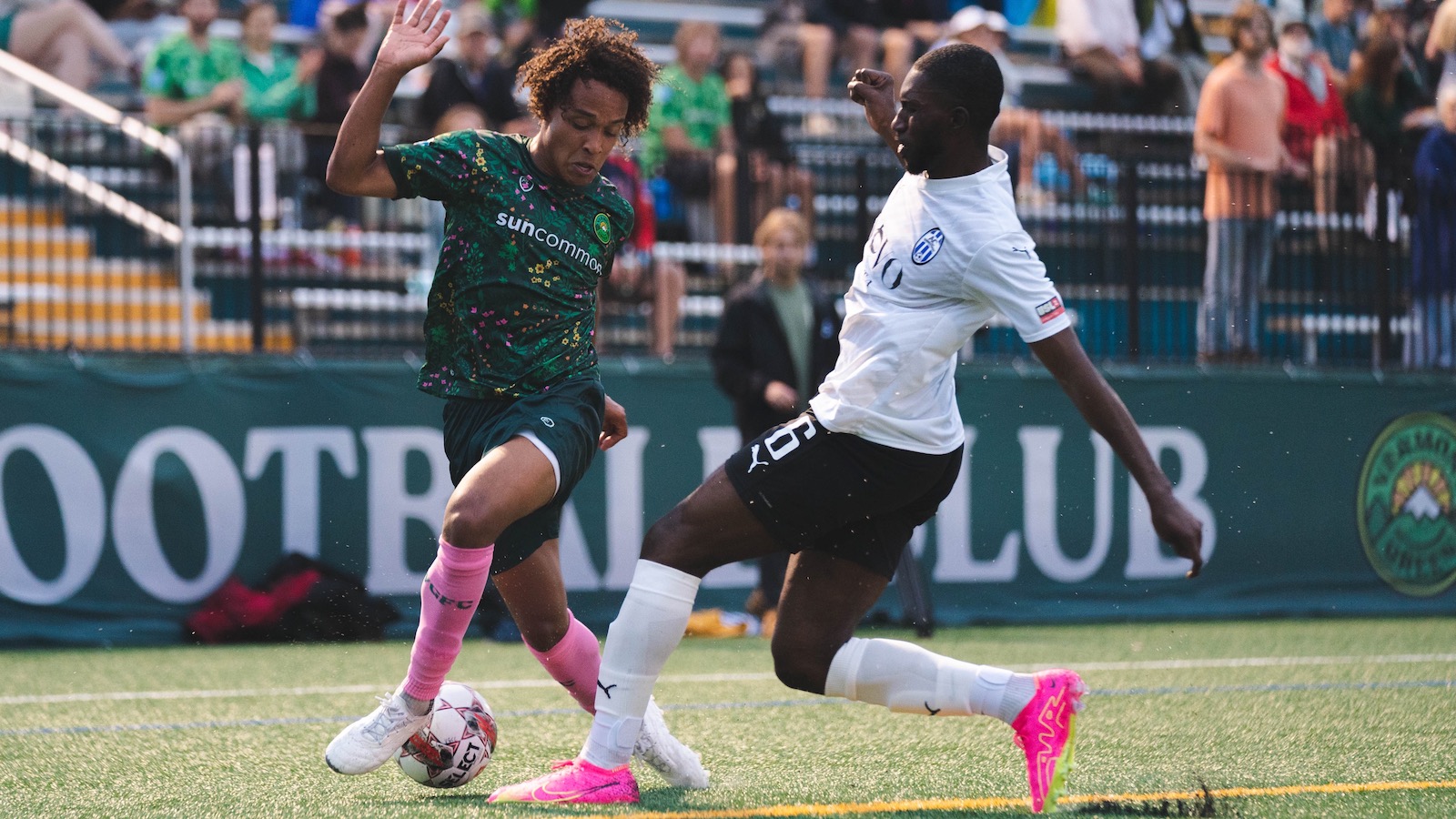This story was co-published with the Guardian.
As the torrent of rain slowed, then faded, the Vermont Green FC surged. The team had already turned a one-goal deficit into a 5-3 lead over AC Connecticut when, in the waning minutes of the match, Green forward Nacho Lerech slid the soccer ball into the back of the net.
The goal all but assured the Green a victory, which would improve its record to 7-2 in league play and send it to the top of the standings. The players rushed to the stands in celebration and were met by 1,533 soggy diehards brandishing a frenzy of flags, drums, and cheers. It was an archetypal sports scene, except for the 80-foot banner hanging to the left of the goal the Green had just scored on. In enormous white letters, it declared: “Climate justice is social justice.”
The sign was, by far, the most prominent in the stadium, rivaled only by an identical one behind the opposing net. And its message is one that the team contends is even more central to its identity than the wins it’s been racking up.
“Everything revolves around our mission,” said Patrick Infurna, one of the six people who co-founded the Burlington-based Vermont Green FC in 2020. The team plays in the USL2 (a fourth-division semi-professional league) and is in its second full season, which runs from mid-May through mid-July. “We’re trying to implement big things and spark big things.”
The Green certainly isn’t the first sports team to address climate change. Most franchises now have some sort of sustainability program, and the Seattle Kraken play hockey in Climate Pledge Arena. But the Green is the only squad in the United States with climate justice as its driving principle, putting it at the vanguard of a burgeoning movement to make sports a platform for climate action.
“You see examples of environmental sustainability in all the leagues in the U.S.,” said Jonathan Casper, an associate professor of sports management at North Carolina State University who researches the intersection of sports and the natural environment. “But not to the extent that you see in Vermont. … [It’s] a core value of the club.”
That was always the plan, said Infurna. The concept, he explained, was born in the early days of the pandemic lockdown and based loosely on the approach of the Forest Green Rovers, a team in England, which in 2018 became the first U.N.-certified carbon-neutral football club. But Infurna and his colleagues wanted to take that idea further by making climate justice a team’s central mission. While the average age of the group hovered around 30, they hoped their combined skills would be enough to make that a reality. One person, for instance, had expertise in climate science; another two — including Infurna — already had professional experience in the soccer industry. And everyone, it turned out, had a connection to Vermont.
“There was no better place to do this for us,” said Infurna of Burlington, a city that elected liberally-minded Bernie Sanders mayor four times and has set an ambitious goal to eliminate fossil fuel use in housing and ground transportation by 2030. That hunch quickly proved correct.

The Green’s first season far surpassed its own expectations. After going 9-4-1 in league play, the squad made the playoffs and Major League Soccer teams drafted three of its players, including Owen O’Malley, who was the Saint Louis SC’s first-ever pick. That leap can be especially rewarding for USL2 athletes, who come largely from college and university ranks and can’t be paid because they would lose their NCAA eligibility.
Fans also came out in droves, and they were soon pushing the 2,500 seat stadium that the Green rents from the University of Vermont to capacity. It’s a trend that’s only accelerated this year, when season tickets (which start at just $65) and nearly every home game have sold out.
Attending a Vermont Green match is in many ways a typical sports experience. There’s a boisterous announcer, an egg race at halftime, and of course a group of superfans: the Green Mountain Bhoys, as they’ve dubbed themselves. In true superfan fashion, the Bhoys have their own section in the bleachers and are dripping in the team’s range of green apparel — before the AC Connecticut match, one member, Tyson Foster, rushed to snag the latest jersey design, bringing his collection to four.
But unlike at other stadiums, the messages the team projects are overwhelmingly climate-centric. Throughout the evening, the PA system boomed with tips on how recycling can help fans reduce their carbon footprints and outlined the benefits of riding a bike to the game. The ads ringing the pitch hawked a solar installer, a green energy investment firm, and a company selling kelp-based nutritional products, among others. Near the food stands there was a bin where fans could drop unwanted T-shirts that will be turned into new clothing — including the merchandise that the Green sells.
The team’s social justice and community initiatives feature prominently as well. One of the signs along the pitch is for the Anti-Racist Soccer Club, a coalition the Green joined that fights racism in soccer. It also helps support — and plays friendly matches against — Juba Star FC, a local team comprised of Somali refugees. When not on the field, Green players often represent the organization around the city and state at events such as Juneteenth celebrations or as volunteers at a local community center for kids.
“We firmly believe that our mission is driving our business success,” Infurna said. At least some players and fans agree.
Forward Denis Krioutchenkov came to the Green from Davidson College in North Carolina and could have joined a summer league closer to home. But Vermont offered more than just high quality soccer. “If I play for a club that’s against all these things that are wrong in the world right now,” he said, “I’ve helped a lot.”
Fans Delanté Keys and his partner, Kyle, were similarly hooked by the soccer but stayed for the mission. “It’s probably why we hold season tickets, versus coming only now and then,” said Delanté, pausing to cheer as the Green scored its fourth goal against AC Connecticut. “Their values align with the state and what people are looking for, and we wanted to go out to support that.”

After getting people through the gate, Vermont Green strives to not only entertain but educate them. One way it does that is by giving each home game a theme, such as renewable energy night or sustainable transportation night. The team highlights the day’s focus with PA announcements, signage, and a halftime show where a team sponsor or community partner addresses the crowd.
The match against AC Connecticut was played on circularity night. The aim was to spotlight the importance of keeping products, and materials, in service as long as possible by designing systems that allow for easy reuse and regeneration. “We can actually take your shirt back and put it back into our supply chain to make more,” Ben Prater told a slowly drying crowd at halftime. He is the sales manager for team sponsor Recover Brands, which makes merchandise for the Green — a partnership the company claims has saved around 33,000 pounds of carbon emissions and over 5 million gallons of water.
The concept of circularity is relatively nascent even for those well-versed in climate lingo, but it’s exactly the type of knowledge the team hopes to impart on fans. “It’s very hard to educate the public about anything that’s related to environmental sustainability,” Casper, the North Carolina State University professor, said, emphasizing that sports can be a nontraditional way of reaching people.
Erin Bucchin, 22, first learned about the Vermont Green at an Earth Day event and attended a handful of games last season. This year, she’s a tailgating season ticket holder. She comes partly for the soccer and partly for the climate focus, which she says has impacted her own sustainability practices. “I learned which plastics are recyclable,” she explained. “No black plastics.”
Sustainability initiatives have proliferated across the industry in recent years, said Roger McClendon, executive director of the Green Sports Alliance, an environmentally focused trade organization. And while he warns that fans, and sponsors, should be on the lookout for inauthentic or half-hearted attempts to capitalize on the sustainability movement, intentional “greenwashing” is relatively rare. “Sports have the power to change,” he said. “There’s some major momentum.”
Infurna says the Vermont Green has faced very little criticism. The only real complaint he noted was about the decision to keep players off the field until the national anthem is finished; a suggestion the Anti-Racist Soccer Club made to avoid putting players in an awkward position. The positive attention, on the other hand, has been overwhelming.

Individual athletes have also been increasingly common catalysts for climate action — especially those competing in sports where the threat of a warming world is most immediately glaring. Cross-country skier Jessie Diggins remembers a 2016 trip to Finland, where the U.S. Ski Team had always gone for virtually guaranteed early-season training. But the snow was melting, the moss was growing, and the skiing was abysmal.
The Green has been written about by the BBC, told its story on the popular soccer podcast Men in Blazers, and fielded numerous inquiries from other sports teams looking to learn more about its work. The intrigue means more work for Infurna and his co-founders, who have yet to take a salary from the Green and all hold other jobs (Infurna has recently been working for the Eintracht Frankfurt soccer team in the German Bundesliga). But, he says, that’s a good problem to have: “We’re hoping this concept proves you can do it anywhere.”
The interest in Vermont Green doesn’t surprise Jessica Murfree, a visiting assistant professor at Texas A&M University who researches the effects of climate change on sport. “I would expect that we start to see more of the strategy that Vermont Green has spearheaded,” she said. She adds that consumers, fans, and sponsors are increasingly using their purchasing power to support such an approach. “They are demanding more these days than just statements.”
“Seeing puddles in the Arctic Circle was the last straw,” she said of her decision to become more active in efforts to combat climate change. ”What if I lean into my platform and use sport to make more of an impact?”

Diggins has since collaborated with the nonprofit Protect Our Winters to use her three Olympic medals (including a gold) as a gateway for advocating climate action. She’s met with everyone from her home state senator Amy Klobuchar of Minnesota to the Conservative Climate Caucus. “Most people get excited by Olympic gold medals,” she explains, “and we use that.”
Unlike for Diggins, climate change has remained a relatively distant threat to the Vermont Green. There’s no snow needed for a soccer match and news outlets commonly list Burlington as one of the best places to avoid the worst effects of climate change. The day after the victory over AC Connecticut, however, wildfire smoke from Quebec rolled across the border and blanketed northern Vermont.
“Rarely are we really hit by the firsthand severity of it,” said Infurna. But as the Air Quality Index climbed above 200, a level the Environmental Protection Agency calls “very unhealthy,” the Vermont Green coaches had to make its Monday practice shorter and less intense.
“It was a holy s— moment,” said Infurna, contrasting a future in which climate change is certain to exacerbate events such as wildfires with the team’s generally upbeat approach to climate action. “We can be optimistic, but we have to be urgent.”



